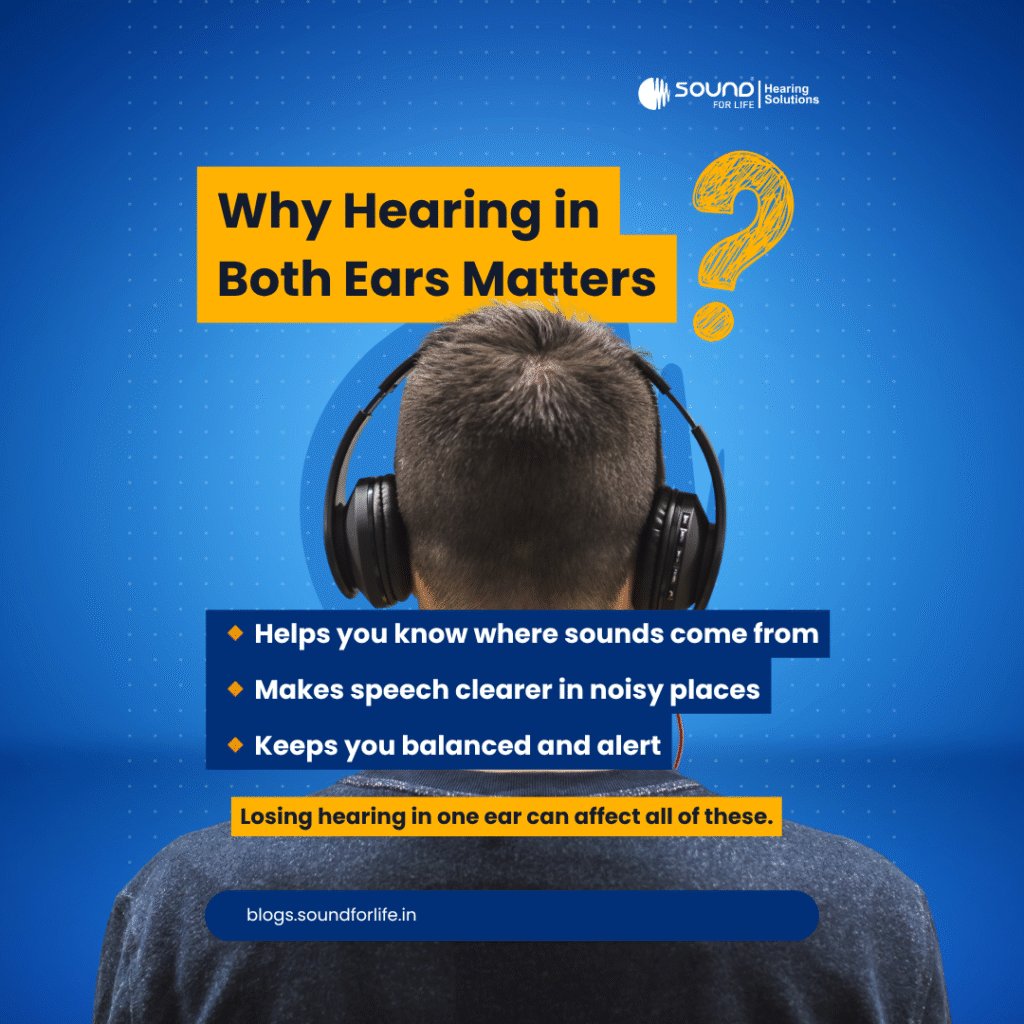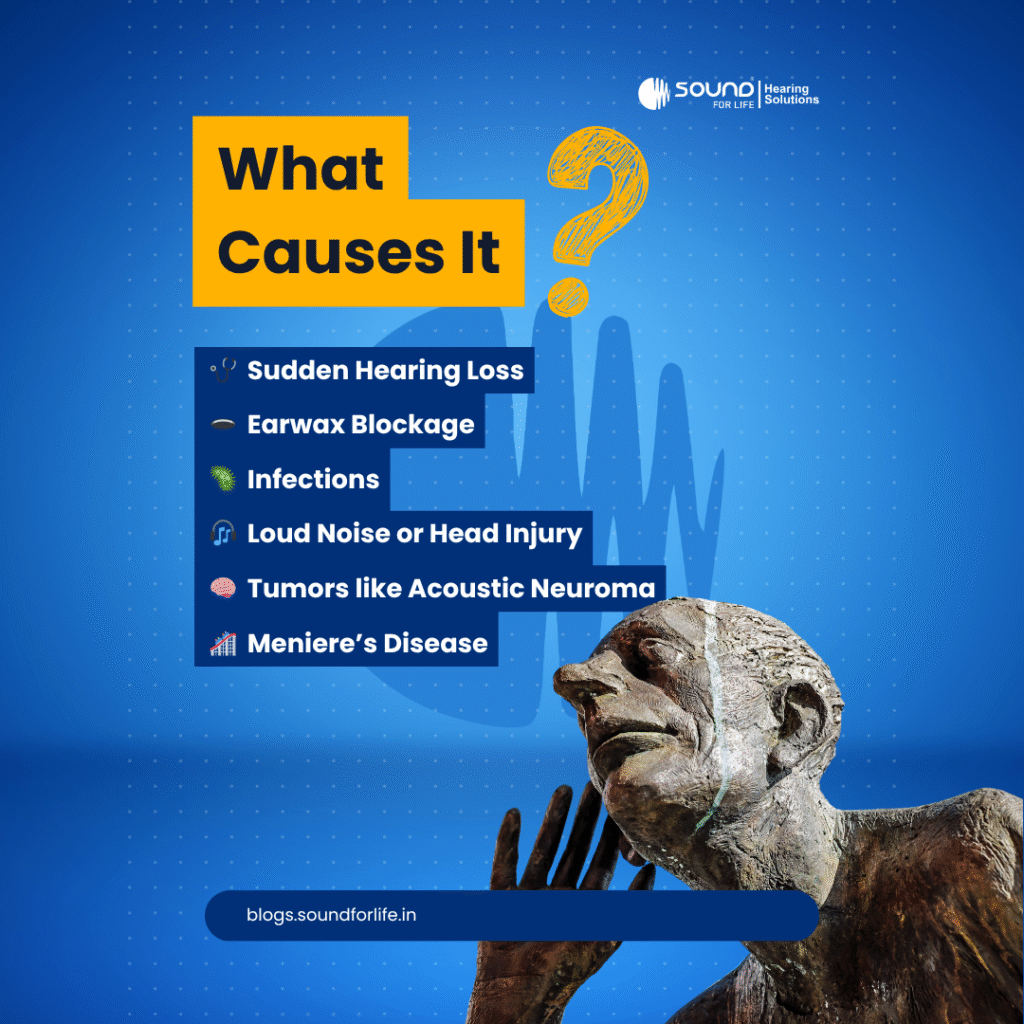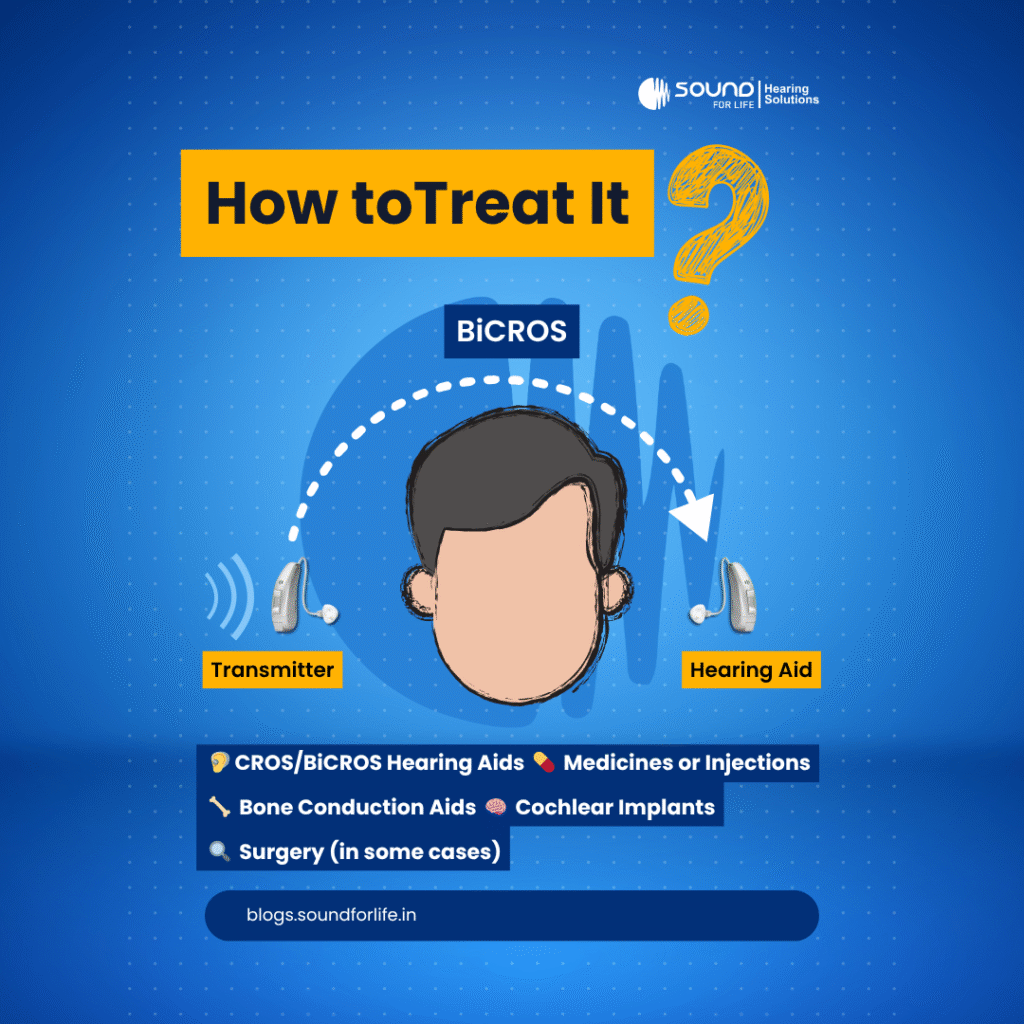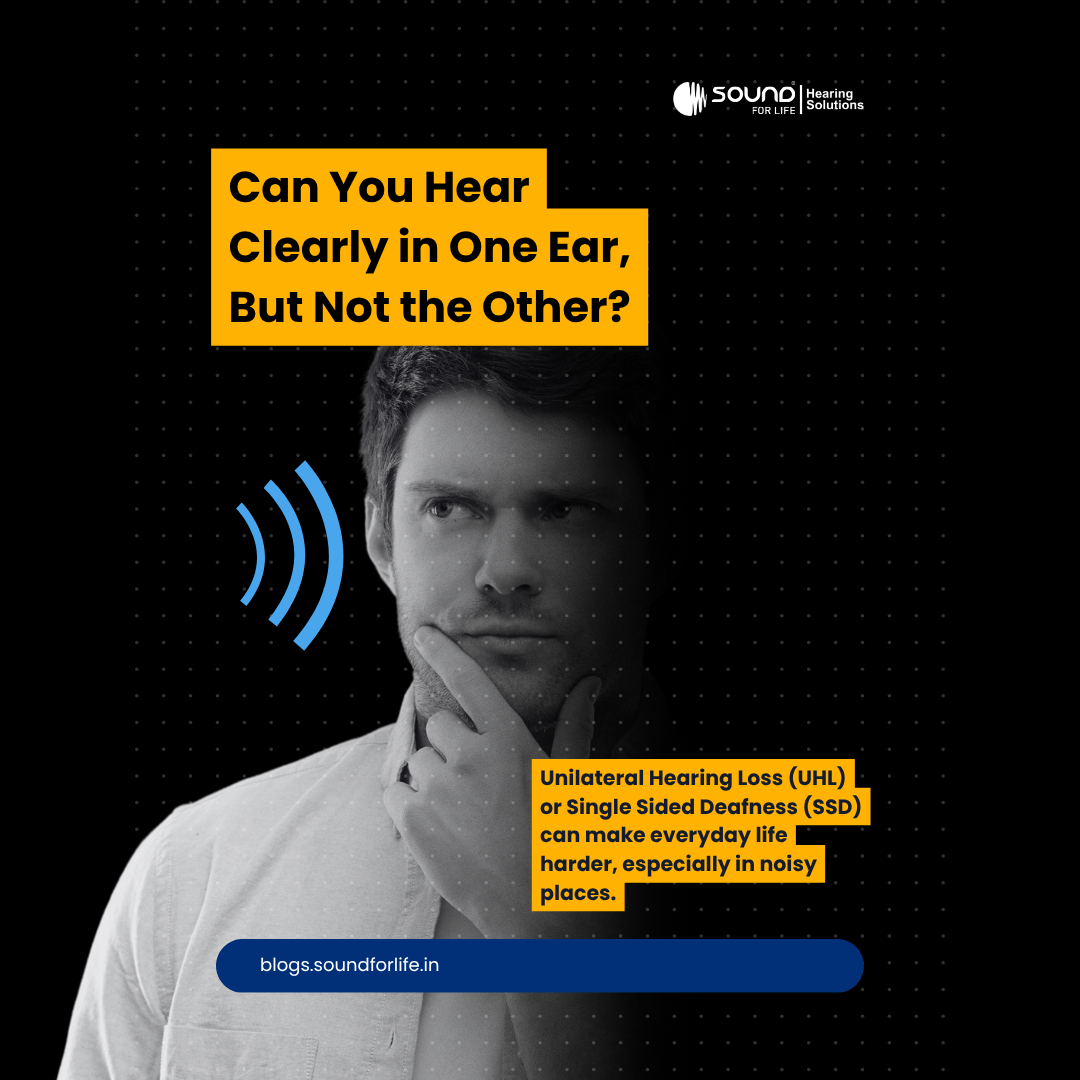Unilateral hearing loss (UHL) means you have normal hearing in one ear but reduced or no hearing in the other ear. If the hearing loss is complete in one ear, it is called single-sided deafness (SSD).
This condition can make it hard to do things you do every day. People who have hearing loss in one ear often have trouble:
- Understand speech in noisy places
- Tell where sounds are coming from (sound direction)
- Hear conversations from their weaker side
- Focus during phone calls or meetings
- Stay alert to dangers like approaching vehicles

Why is it important to hear with both ears?
Our ears work together. Hearing in both ears helps us:
Locate sounds: When a sound comes from the left, your left ear hears it a little bit before your right ear does. Your brain uses this timing to figure out where to go.
Understand speech in noise: Your brain can focus on voices and block out background noise when you have two ears.
Balance sound: When you hear from both sides, the sound feels “centred” and real.
These skills get weaker when one ear doesn’t work well. You might feel like you’re off-balance, have to turn your head all the time to hear better, or feel alone in social situations.

Things that can make you lose hearing in one ear
There are a lot of things that can make a person lose hearing in one ear. It can happen all at once or over time, and the reasons are different for each person depending on their age, lifestyle, and health.
1. Sudden Sensorineural Hearing Loss (SSHL)
This is an emergency in the medical field. It involves rapid hearing loss in one ear, usually within 24 to 72 hours. It might feel like the ear is “blocked” or “full,” and then you really lose your hearing.
Causes include:
- Viral infections
- Blood circulation problems in the inner ear
- Autoimmune diseases
- Stress or trauma
Some patients get better quickly if they get treatment within the first 24 to 48 hours. Steroids (taken by mouth or injected) and sometimes antivirals are common treatments.
2. Blockage or buildup of earwax
Hearing loss in one ear can sometimes be as simple as wax blocking the ear canal. This makes you feel full and makes the sound less loud.
Solution: See a doctor, don’t try to clean it on your own with cotton buds.
3. Infections in the ears
Otitis externa (an infection of the outer ear) or otitis media (an infection of the middle ear) can make one ear temporarily deaf. This happens more often in children, but it can happen to anyone.
Symptoms: Pain, fluid drainage, fever, or fullness in the ear.
Treatment: Antibiotics or ear drops.
4. Acoustic Neuroma (Vestibular Schwannoma)
This is a non-cancerous tumor that grows on the nerve that controls hearing and balance. It develops slowly and usually only affects one ear.
Symptoms:
- Gradual hearing loss in one ear
- Ringing (tinnitus)
- Dizziness or balance problems
An MRI or CT scan is required to confirm the diagnosis, and management may involve surgery, radiation therapy, or active monitoring.
5. Injury or trauma
From a sudden blow to the head, to the thunderous crack of gunfire or fireworks, and even the rapid shifts in pressure you experience when flying or diving, all of these forces can damage your auditory system and result in hearing loss in one ear.
6. The disease of Ménière (Inner ear-condition)
A problem with the inner ear that makes you suddenly lose hearing in one ear.
- Sudden hearing loss in one ear
- Ringing or roaring sounds
- A feeling of pressure
- Spinning sensation (vertigo)
Ménier’s is a long-term condition, but it can be managed with diet, medicine, and sometimes surgery.
7. Otosclerosis
Otosclerosis is an abnormal overgrowth of bone in the middle ear that interferes with the normal movement of the ossicles, leading to diminished sound transmission and conductive hearing loss. Although this condition most commonly progresses in both ears, it can start on affecting only one side before spreading.
Signs of Hearing Loss in One Ear
It’s not always easy to tell if someone has lost hearing in one ear. Many people either ignore the changes or get used to them. Here are some common signs:
- Difficulty hearing when the speaker is on one side
- Always turning your “good ear” toward sound
- Trouble hearing in noisy places
- Ringing or buzzing in one ear (tinnitus)
- Dizziness or balance problems
- Missing parts of conversations or needing repetition
- Trouble using the phone on one side
Tests and Diagnosis
If you or someone you know has one-sided hearing loss, you should see an ENT doctor or audiologist. They might suggest:
- Pure tone audiometry: Tests how well you can hear in each ear.
- Tympanometry: Checks how well the middle ear works.
- Speech discrimination tests: Find out how well you can hear words.
- MRI/CT scan: If a tumor or nerve issue is suspected.
Getting early diagnosis is very important, especially for sudden hearing loss.

Ways to Treat Hearing Loss in One Ear
The type of treatment will depend on what caused the hearing loss, how bad it is, and how long it has been going on. These are some common choices:
1. Medical Care
Doctors may suggest the following for hearing loss that comes on suddenly or is caused by an infection:
- Steroids: Taken by mouth or injected near the ear
- Antibiotics: For treating infections
- Decongestants or antihistamines: If caused by allergies or sinus issues
Prompt medical attention within 24 to 48 hours of any sudden hearing loss is essential.
2. Hearing Aids
Hearing aids may help if hearing can’t be fully restored. Using a device in the affected ear can make the sound clearer overall, even if one ear is working.
- Improve overall sound clarity
- Help localize sound
- Reduce ear strain
Hearing aids for people who can only hear out of one ear:
CROS (Contralateral Routing of Signal) is for people who can’t hear in one ear. A wireless connection sends sound from a microphone on the bad ear to the good ear.
BiCROS: For people who have some hearing loss in their better ear as well.
Bone Conduction Aids: Send sound to the better ear by vibrating the skull. Good to have if the ear canal is blocked or hurt.
Phonak, Signia, and Oticon are well-known brands that make CROS and BiCROS systems.
3. Cochlear Implants
If the hearing loss is severe and hearing aids don’t help, cochlear implants may be recommended. These are small electronic devices that stimulate the hearing nerve directly.
Cochlear implants can restore sound awareness and improve quality of life, especially in young children or adults with recent hearing loss.
4. Surgery:
For conditions like otosclerosis, tumors, or cholesteatoma, surgery may be needed. An ENT specialist will guide you based on test results.
Having Hearing Loss in One Ear
A lot of people live full lives even though they can’t hear in one ear. Here are some ways to manage better:
- Tell people about your hearing needs. Ask them to speak on your stronger side.
- Use visual cues: Look at the speaker’s face to help with lip reading.
- Avoid noisy places or choose quieter corners in restaurants.
- Use hearing technology: TV streamers, Bluetooth devices, or specialized apps.
- Try assistive devices: Personal sound amplifiers, vibrating alarms, or captioned phones.
- Regular checkups: Visit your audiologist every 6–12 months.
What You Should Know About One-Ear Hearing Loss in India
In India, individuals experiencing hearing loss in one ear frequently receive delayed or incorrect diagnoses, often because many assume the problem will resolve on its own. Unfortunately, postponing evaluation and treatment beyond the first critical days can lead to irreversible damage. Prompt assessment by a qualified ENT specialist or audiologist, ideally within 24 to 48 hours of symptom onset is crucial to preserve any remaining hearing.
- But the good news is that there are qualified ENT specialists and audiologists in big cities like Delhi, Mumbai, Bengaluru, and Chennai.
- Certified clinics sell hearing aids and CROS systems.
- Phonak, ReSound, Oticon, and Signia are some of the brands that make devices for people who have lost hearing in one ear.
Important Points
- Unilateral hearing loss or single-sided deafness is when you lose hearing in one ear.
- Infections, nerve problems, tumours, trauma, or earwax could all be to blame.
- It’s very important to get treatment right away, especially for sudden loss.
- You can get medical help, hearing aids (like CROS/BiCROS), cochlear implants, or surgery.
- People with hearing loss in one ear can live full, active lives with the right help.
When to seek help
- If you suddenly can’t hear in one ear, get medical help right away.
- You feel dizzy, your ears hurt, or you hear ringing.
- Your child isn’t responding to sounds on one side.
- You have trouble hearing sounds or understanding what people say.
- An ENT doctor or audiologist can do tests and tell you what to do next.
Living with hearing loss in one ear can be challenging, but it’s possible. You don’t have to suffer in silence anymore because of modern hearing aids, medical care, and awareness. Don’t ignore changes in your hearing, no matter if you’re a young professional, a parent, or an older person.
Trust your instincts, book a comprehensive ear evaluation today at SFL Hearing Solutions. If you need help picking the right hearing aid, reach out to our expert today for personalized guidance.





